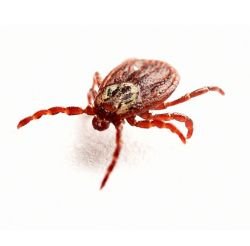Ticks

Identification
The coloration of ticks also varies between species but is usually brown or blackish-brown.
The size of ticks varies between 3 mm to 5 mm long.
Ticks have a flattened oval-shaped body, which becomes engorged when they feed on the blood of their hosts. They are covered in hard exoskeletons that protect them from being crushed and also help them retain moisture.
Get A Free Quote
We are affordable Pest Control Service in GTA & Surroundings Areas.
What are ticks, where do they come from, and how do they spread disease?
Ticks are small parasitic arachnids that feed on the blood of their host animals. With over 850 known species, ticks come in various shapes, sizes, and colors. Some common types of ticks include the black-legged, American, and brown dog ticks.
The black-legged tick is also known as the deer tick and is typically found in wooded areas. They have a reddish-brown body with black legs and can transmit Lyme disease to humans. The American dog tick has a brown body with white or yellow markings on its back and can be found in grassy areas. This type of tick can transmit Rocky Mountain spotted fever to humans.
Lastly, the brown dog tick is primarily found indoors or around kennels where dogs are present. They have a reddish-brown body and do not transmit diseases, but they can cause anemia in dogs due to excessive feeding. Identifying these different types of ticks can help individuals take proper precautions to prevent bites from these potentially harmful parasites.
Tick Identification
Mosquitoes are small, flying insects that belong to the Culicidae family. They are known for their blood-sucking capabilities, which they use to feed on humans and animals alike.
your home from the dual threat of ticks and weevils with our comprehensive guide to effective pest management strategies.
Mosquitoes have an intricate biology that allows them to fly up to 1-1.5 miles per hour and reach heights of over 25 feet. Their wings beat incredibly fast rates, around 400-600 times per second, allowing them to generate lift and stay airborne. Mosquitoes primarily feed on nectar from flowers and plants, but females require blood meals to develop their eggs.
Female mosquitoes lay their eggs in standing water or areas prone to flooding, such as drains or ditches. Once hatched, mosquito larvae live in water until they pupate into adults within just a few days. After emerging from their pupal cases as fully developed adult mosquitoes, females seek out a host for a blood meal before reproducing themselves.
Understanding the biology of mosquitoes is crucial for controlling populations and preventing the spread of diseases such as malaria, dengue fever, Zika virus, and West Nile virus that can be transmitted through mosquito bites. By knowing how they fly, what they eat, and how they reproduce, we can better protect ourselves against these pesky pests while preserving our ecosystem’s delicate balance.
Habitat, Diet, and Life Cycle of Ticks
Ticks are found in many parts of Canada, inhabiting various habitats such as forests, fields, and even urban areas. They are small arachnids that feed on the blood of mammals, birds, and sometimes reptiles. Ticks are known to transmit diseases such as Lyme disease, making it important to understand their habitat, diet, and life cycle.
Regarding their diet, ticks require blood to survive and reproduce. They usually attach themselves to the host animal by burrowing their mouthparts into the skin and feeding on the host’s blood. Ticks can feed on various animals, including humans, dogs, deer, and birds.
The life cycle of a tick typically consists of four stages – egg, larva, nymph, and adult. Each stage requires a blood meal to progress to the next stage. The duration of the life cycle can vary depending on the species of the tick and environmental conditions. For instance, some ticks may take up to two years to complete their life cycle. Ticks are found in various habitats in Canada, including the boreal forest, mixed wood forest, and tundra. The Canada lynx, which is highly adapted to hunting its primary prey, the snowshoe hare, is known to inhabit these habitats. While the diet of Canada lynxes consists mainly of snowshoe hares, it may also include other small mammals such as squirrels and rodents.
In conclusion, ticks are an important part of Canada’s ecosystem but can also pose a risk to human and animal health. Understanding their habitat, diet, and life cycle is essential in preventing tick-borne illnesses.
Residential Pest Control Service
Customized pest control treatments can be used to safeguard your living space against bothersome pests and ensure that they don’t become a nuisance in your home.
Prevention and Treatment
Preventing tick bites can be done in several ways. Firstly, wearing protective clothing when going outdoors, such as long-sleeved shirts, pants, and closed-toe shoes, is essential. Tucking pants into socks or boots also help prevent ticks from crawling up the legs. Secondly, using insect repellent can reduce the risk of tick bites. Also, avoiding areas with high grasses or leaf litter may decrease contact with ticks.
If a person does get bitten by a tick and experiences symptoms such as fever, headache, muscle pain or rash within weeks of being bitten, they should see a doctor immediately. Treatment for tick-borne diseases varies depending on the type of disease contracted but typically involves antibiotics such as doxycycline and amoxicillin for bacterial infections like Lyme Disease. Most people recover fully after appropriate treatment; however, long-term complications can occur if treatment is delayed.
In summary, preventing tick bites includes wearing protective clothing, using insect repellent outdoors, and avoiding areas with high grasses or leaf litter. If someone does experience symptoms after being bitten by a tick, seeking medical attention promptly is crucial to receive proper treatment before complications arise.
